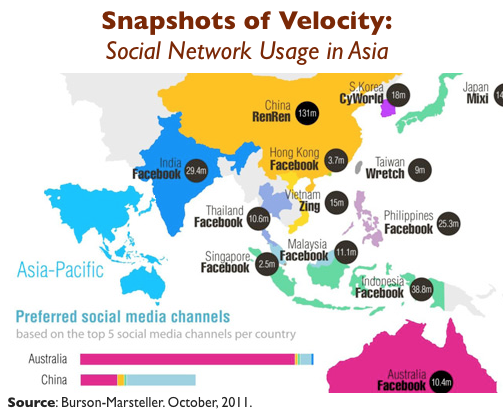Social business around the world

Last week I had the distinct privilege of traveling in Asia and Eastern Europe to speak about social business and get a sense of the progress the industry has made elsewhere in the world. While social media has been a leading trend in the West for well over four years, the rise of the medium in Asia has been a more recent phenomenon. But just like the uptake of MySpace, then Facebook, Twitter, and now Pinterest was practically exponential in their early days, only slowing when they fundamentally ran out of users, the same is now taking place in Asia in particular.
In fact, both the bottom line numbers and the rates of adoption in Asia now substantially eclipse the rest of the world. And what I learned was fascinating: While Facebook and Twitter are often quite popular, local social networks are now largely leading the space. And for all the talk of consumer social media, the business sensibility and focus of many social network in the East is much more focused, upfront, and taking place earlier than it did in the United States and elsewhere in the West. The pattern of adoption is different as well, as much dictated by political fiat as it is by cultural reasons or usage habits. For example, Facebook, Twitter, and host of other largely United States-based sites are blocked by the People's Republic of China, for example.
The implications of this rapid growth and transformation in the global social media landscape is that it now seems likely that social balkanization will occur more extensively than it appeared it would before. This is part of the channel fragmentation problem I've often noted is endemic to social ecosystems that aren't well integrated and which is a signature challenge of the industry. Fortunately, it's also one that is now being dealt with well by the latest crop of social listening and analytics platforms which create coherent pictures of activities for businesses, though most consumers aren't availing themselves of such options (nor in fact are most aimed at them.)
No, the Asia and Eastern European world of social networking looks quite different than it does here in the United States. Names like RenRen (China), Weibo (China), Mixi (Japan), CyWorld (Korea), Odnoklassniki (Russia), and VKontakte, represent some of the largest social network offerings I encountered there.
Sizing up Social Business in China
Since then, Weibo has nearly doubled their users to 250M in the last year alone and RenRen has done much the same. Speaker Julien Chiavassa further noted that China has added more Internet users in the least 3 years than exist in the entire United States. RenRen's Donna Li gave a detailed explanation of the many business models that the social networking platform uses including group buying (saying their the most successful in the world), open APIs, app stores, and even a social credit card.
Sam Fleming, a well known figure in social media in Asia, noted that social media centers of excellence (what I've called a social business unit) are now becoming standard fare, much like they are in the United States today. IBM's Alistair Rennie even made an appearance, talking about IBM's social business journey as well as the experience of their global customers, noting for example that they are in the process of transforming their entire customer care model to be primarily social, ala Social CRM. I also spoke as well and my slides will be up on Slideshare soon.
The trends are clear: Just like China will be the world largest economy soon enough, it's already taking the social world by storm. Overall, I was impressed with the business acumen and maturity that was evident in the social business community, even if it was often very different than ours. Users for example are less likely to want to share personal information in China, even as they are much more likely to collaborate on activities that are not overly personal.
Social Business in Russia
While we reviewed many of the principles from our new book on social business, the audience was primarily hungry for real-world examples of organizations that have been particularly successful. This always seems to be the case in audiences in general, even if they have issues adapting the example to their industry. Twitter and Facebook are more popular there (and aren't blocked) and Facebook pages, Twitter account names, and other social networking URLs are quite prevalent in advertising there.
If fact, if there was a surprise, it was that use of mobile devices and laptops, both in the conference, and elsewhere was quite low compared to the constant in-your-face use that is common both here in the United States and China. It was also interesting to see, despite Russia's competency in software development, that most users were looking at social business platforms from the United States, such as Jive or Microsoft SharePoint.
The Round-the-world Social Business Takeaway
If nothing else, the trip confirmed that social has become a truly global phenomenon that has established plenty of local color and nuance. Large enterprises have their work cut out for them to adapt their social media strategies to local vagaries and differences when it comes to listening and engaging with communities of customers, workers, and business partners. There's little doubt that the eclipsing of English social networks by much larger Asian and Eastern social networks in general is going to have serious business impact, with cultural impact impeded for the time being by language -- and in some cases political -- barriers. I'd also say that we have some lessons to learn about experimenting with and adopting new digital business models in our social networks and social business platforms here in the United States.
For those organizations that much have engagement strategies that span multiple countries in this region, being prepared for a changing landscape and the continuing entry of new players as social business evolves will be essential.
